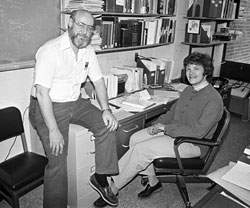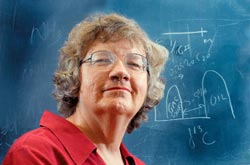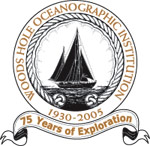This is an archived site. This site is no longer being maintained or reviewed for broken links.
Employee Portrait Gallery—Jean Whelan
 |
|
|
This portrait of Jean Whelan and John Farrington was taken for the 1984 annual report to accompany an article they wrote with John Hunt on petroleum geochemistry. (Photo by Shelley Dawicki) |
|
 |
|
A quote attributed to Jean Whelan that accompanied this picture of her in the recently published case statement for WHOI’s capital campaign said: “ If you think like a geologist, reservoirs are fixed and predictable. But if you think like an oceanographer, you have to ask whether geological processes can happen faster. We . . . began to consider how much gas was migrating through the system, and whether it could be seeping up into the ocean, refilling the reservoir.” (Photo by Bridget Besaw-Gorman) |
|
What draws a native of the Nevada desert who didn’t even see the ocean till she was a teenager to the coast? As a youngster, Jean Whelan lived with her grandfather, who was Dean of Engineering at the University of Nevada in Reno, and she was “always interested in gadgets and how things worked.” After completing undergraduate studies at the University of California, Davis, Jean came east and earned a Ph.D. in organic chemistry from MIT. After a postdoc at Brandeis, she taught “every kind of chemistry except physical” (and still no oceanography!) at Fairleigh Dickinson University for eight years. Colleagues at the university’s marine lab in St. Croix interested Jean in how organic chemistry might be useful for ocean studies. Through an MIT colleague then at WHOI, she arranged to spend a sabbatical in John Farrington’s lab—and fell in love with oceanography. She gave up straight chemistry for organic geochemistry, became a guest investigator in the early 1970s, and soon after joined the technical staff, working for John Hunt. Since then, Jean’s research has focused on gases, primarily methane and light hydrocarbons, in ocean sediments, and more recently, in ocean waters. She has also studied gas and oil migration processes, and she rates as a major find her research group’s demonstration of in situ deep sediment microbial sources for these substances. Jean has been a leader in recent work on previously unrecognized subseafloor methane repositories and is currently working with WHOI engineers to develop in situ instruments to make continuous measurements of this and other volatile gases in the deep ocean, along with their effects on ocean and atmosphere. Though she is officially retiring this fall , Jean plans to remain an active presence at WHOI.
In 1983, Jean was the first woman named a senior research specialist. Colleagues consider her a wonderful mentor and caring supporter. One said, in nominating her for the Linda Morse-Porteous Award, which she received in 1998, “Her enthusiasm is contagious, and she has a way of putting a positive spin on things, even when none of my instruments are working!” Her generosity is also expressed in the endowed Robert Whelan award, given by Jean in memory of her late husband and open to “all full time members of the [MCG} department, with an emphasis on groups that are commonly neglected by other Institutional grants and prizes.”
[back]

